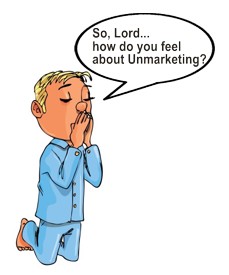 (I’ve asked several nonprofit CEOs for their comments on what I’ve written so far and I’m meeting some resistance. “This would require a major change in how we deal with our supporters,” was a common concern. I also heard, “This is a shoestring operation. Surely you don’t think we have an extra hour in our day.” Actually implementing social media marketing, to a great degree, is scalable… and don’t call me Shirley (I couldn’t resist.) Another complaint was “It’s a lot of work without any assurance of a return.” This was the easiest objection to overcome because I’ve got the studies that support the claims and will point you to them in my next post.
(I’ve asked several nonprofit CEOs for their comments on what I’ve written so far and I’m meeting some resistance. “This would require a major change in how we deal with our supporters,” was a common concern. I also heard, “This is a shoestring operation. Surely you don’t think we have an extra hour in our day.” Actually implementing social media marketing, to a great degree, is scalable… and don’t call me Shirley (I couldn’t resist.) Another complaint was “It’s a lot of work without any assurance of a return.” This was the easiest objection to overcome because I’ve got the studies that support the claims and will point you to them in my next post.
This post details how to begin to use tools to make your web site more effective. This is the first step to releasing the power of UnMarketing for your organization. Simply opening a Twitter account or creating a Facebook page is relatively easy. Choosing keywords and analyzing website traffic requires some detailed work and calls for the mastery of several software tools. However if you’re going to put the effort into social media marketing, you must able to evaluate your results. That’s where the toolbox comes into play.)
Let me assume your organization has a website (If it doesn’t, that’s OK. Future posts will show you how to create a great looking site for less than $100.) But for now, here are some questions about your site:
1. How many unique visitors viewed your site last month?
2. What pages did they visit?
3. What was the most popular page to enter your site?
4. What was the average time spent on each page?
5. What was your site’s most popular exit page (the last page visited)?
6. How did visitors find your site?
7. If they found it using a search engine, what key words did they use?
8. If your site accepts donations, what was the average donation?
9. What are the keywords for each page on your site?
If you knew the answers to these questions, then you are probably using a statistics or analytics program to monitor your site. If not, this is the first tool for your toolbox. I use Google Analytics. It’s free and moderately easy to learn. You set up an account, include a short ID code on your site’s pages, and visit your GA account regularly to find out who is visiting your site and how they are interacting with it.
The next program for your toolbox will help you choose the best keywords for your site. Keywords are the search terms people enter into a search engine when they are looking for your site (or when they are looking for information that your site has to offer, even if they have never heard of your organization.) The tool I use to choose keywords is the Google Keywords Tool. While you don’t need to open a free account, you can use the same free account that you use for Google Analytics. There is more work involved with choosing great keywords and I will offer suggestions in a future post. But for now, let me tell you about Lynda.com a great place to get training on Google Analytics, choosing keywords, building a WordPress website and much more. (Disclaimer — I am not affiliated with or compensated in any way by the companies I recommend. I recommend them because I use them and like them. I will also report on problems I’ve experienced, if any.)
Lynda.com is a site that offers online training on more than a 1000 software packages. There are several paid training options available and even a way to learn the material for free. If your schedule permits, you can take all of courses I recommend during a 7 day free trial (cancel after 6 days to be sure you won’t be charged.) Take the following courses to learn how to use the tools I’ve recommended:
- Search Engine Optimization Getting Started (2010) (2 hours 20 minutes)
- Google Analytics Essential Training (4 hours 54 minutes)
There are also good courses on WordPress and site design and planning.
I have just recommend two courses that run over 7 hours and the keyword selection process will take a few more hours. How can this be accomplished in an hour a day (5 hours a week)? Easy. Take your time. Let’s look at a proposed weekly schedule of effective UnMarketing after three to six months of an hour a day of getting ready to use social media effectively (setting up and using Google Analytics and developing a great set of keywords for your site.)
- Posting 10 to 15 Tweets a week — 1 Hour (first few will take longer)
- Writing one 500 to 700 word blog post a week — 2 Hours (two blog posts a week would be better, but give it time)
- Facebook maintenance — 1 Hour (10 to 15 minutes a day)
- Research (for blogging and Twitter) — 1 Hour
Will this be worth 5 hours of your precious time a week? That’s the subject of my next post.
Next Up: “UnMarketing in Action: Does it Really Work?’ ”

 Twitter just celebrated its sixth birthday and now claims 140 million active users. Facebook has 845 million users. That’s lot of people sharing everyday happenings with their friends. Contrast a Facebook or Twitter user reading a friend’s postings with how you feel when called by a telemarketer. One event is a welcomed social exchange and the other an invasion of privacy. Old style marketing methods (cold calling and unrequested emails) are being replaced by a new approach to donor relationships referred to as Unmarketing, Inbound marketing, or relationship marketing.
Twitter just celebrated its sixth birthday and now claims 140 million active users. Facebook has 845 million users. That’s lot of people sharing everyday happenings with their friends. Contrast a Facebook or Twitter user reading a friend’s postings with how you feel when called by a telemarketer. One event is a welcomed social exchange and the other an invasion of privacy. Old style marketing methods (cold calling and unrequested emails) are being replaced by a new approach to donor relationships referred to as Unmarketing, Inbound marketing, or relationship marketing.

